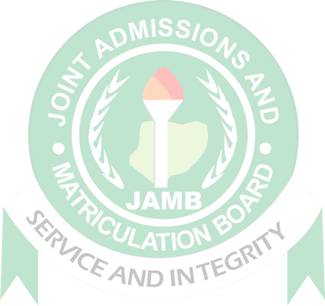
Chemistry
Paper 1 | Objectives | 49 Questions
JAMB Exam
Year: 1990
Level: SHS
Time:
Type: Question Paper
Answers provided
FREE
No description provided
Feedbacks
This paper is yet to be rated

Paper 1 | Objectives | 49 Questions
JAMB Exam
Year: 1990
Level: SHS
Time:
Type: Question Paper
Answers provided
No description provided
This paper is yet to be rated
8 Tips To Be More Productive in Test Revision for good grades and higher performance in exams
Make sure you study hard but not into the late-night hours to give your body the enough rest you need.
Try studying past questions since it's a sure way to better grades in any subject at school and beyond.
| # | Question | Ans |
|---|---|---|
| 1. |
Which of the following is a physical change? A. The bubbling of chlorine into water B. The bubbling of chlorine into a jar contanining hydrogen C. The dissolution of sodium chloride in water D. The passing of steam over heated iron |
C |
| 2. |
In a reaction: \(SnO_{2} + 2C → Sn + 2CO\) the mass of coke containing 80% carbon required to reduce 0.302 kg of pure tin oxide is? A. 0.40 kg B. 0.20 kg C. 0.06 kg D. 0.04 kg
Show Content
Detailed SolutionIn the reaction: \(SnO_{2} + 2CO\)From the equation above 2(12 g) carbon = 151 g \(SnO_{2}\) 24 g carbon =151 g \(SnO_{2}\) = 0.302 kg \(SnO_{2}\) = 24/151g χ 0.0302 kg carbon = 0.048 kg carbon Mass of coke is required not mass of carbon,so it is (0.048\(\times\)100)\(\div\)80 = 0.06 |
|
| 3. |
Cr2O7 + 6Fe2+ + 14H+ → 2Cr3+ +6Fe3+ + 7H2O. In the above , the oxidation number of chromium changed from? A. +7 to +3 B. +6 to +3 C. +5 to +3 D. -2 to +3 |
A |
| 4. |
In the reaction 1O-3 + 5l- + 6H+ → 312 + 3H2O, the oxidizing agent is? A. H+ B. l- C. 1O- D. l2 |
C |
| 5. |
Fe\(_2\)O\(_{3(s)}\) + 2Al\(_{(s)}\) → Al\(_2\)O\(_3\) + 2Fe\(_{(s)}\). If the heats of formation of Al\(_2\)O\(_3\) and Fe\(_2\)O\(_3\) are - 1670 kJmol\(^{-1}\) and - 822 kJmol\(^{-1}\) respectively, the enthalpy change in kJ for the reaction is ? A. +2492 B. +848 C. -848 D. -2492
Show Content
Detailed SolutionHeat of formation = Heat of products - Heat of reactants= - 1670 - (- 822) = - 1670 + 822 = - 848 kJ |
|
| 6. |
Iron galvanized with zinc is cathodically protected from corrosion. This is because? A. zinc has a more positive oxidation potential than iron B. zinc has less positive oxidation potential than iron C. bith have the same oxidation potential D. zinc is harder than iron |
B |
| 7. |
Which of the following samples will react fastest with dilute trioxonitrate (V) acid? A. 5 g of lumps of CacO3 at 25°C B. 5 g of powered CacO3 at 25° C. 5 g of lumps of CaCO3 at 50°C D. 5 g of powered CaCO3 AT 50°C |
D |
| 8. |
In the reaction: A. raising the pressure B. raising the temperature C. adding a catalyst D. lowering the pressure |
B |
| 9. |
Which of the following gases can be collected by the upward displacement of air? A. NO B. H 2 C. NH3 D. Cl 2 |
D |
| 10. |
The brown fumes given off when trioxonitrate (V) acid is heated consist of ? A. NO2 and O2 B. H2O and NO2 C. NO2' O2 and H2O D. NO, NO2 and H2O |
C |
Preview displays only 10 out of the 49 Questions